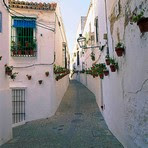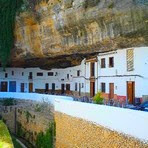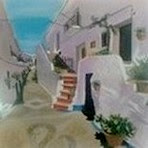Home »
Los Pueblos Blancos
» ZAHARA de la SIERRA, importante production fruitière...
ZAHARA de la SIERRA, importante production fruitière...
Appelée autrefois « Zahara de los Membrillos », ce village devait son nom à son importante production fruitière (membrillo signifie « coing »). Son site privilégié au sommet d’une colline en fit aussi l’un des maillons du système défensif nasride. Au pied de Zahara de la Sierra s’étire une vallée verdoyante marquée par le lac du barrage de Zahara (beaux panoramas du haut du château du 12e s.). Sur la place du village blanc tout à fait typique, admirez l’église baroque de Santa María de Mesa (18e s.).
By Dee McMath
The white village of Zahara de la Sierra is one of the most stunning images in the Province of Cadiz. As you drive on the A382 road, which links Arcos de la Frontera with Antequera, or the A376 from Seville to Ronda you see a castle built high on a rocky mountain peak and scattered below it are the whitewashed houses of Zahara de la Sierra, which lead down to a man made lake at the foot. Zahara was once described by Richard Ford, the romantic British traveller, as a "Moorish eagle's nest". In fact, the town dates back to Moorish times. The inhabitants lived in constant danger as Muslims and Christians fought over ownership. In 1407 the Christians were in control, thanks to the conquest of Don Fernándo. In the 18th century the Duke of Arcos had a stately home in Zahara, giving great importance to the area.
Today's Zahara de la Sierra is becoming ever more attractive to the more discerning tourist of Andalucia and this is especially true at the famous fiesta of Corpus Christi, which has been declared to be of National Tourist Interest. The people of Zahara dress up the fronts of the houses with branches and rushes, making the whole place look as if it were part of nature. It is well worth visiting during this festival.
The reservoir, which is a relatively new edition to the area, has made it even more popular with visitors, who also have the option of water sports and swimming, which didn't exist 10 years ago.
There are many interesting sights, such as the Watch Tower, dating back to the 16th century, the Torre del Homenaje, the Church of Santa María de la Meza with its baroque altarpiece and the Arch of the Town. Indeed Zahara de la Sierra was given the title of Artistic Centre in 1983.
From a social point of view, over the last 30 years or so, more than 2,000 of the population have migrated, mainly to the Costa del Sol in search of work in the hotel industry. Many of these people work the summer season and come back in winter to the peace and quiet of their hometown. Since the town, which covers an overall area of over 70 square kilometers, is built on the sides of the hill ranging from a height of 300 meters above sea level in the north and 1,100 in the south.
Accommodation and restaurants in the area are generally more modest than in larger coastal areas and there is less evidence of the British influence, thus giving the traveller a chance to really sample the local dishes and wines for a real taste of Spain.
Just outside the town an old olive mill has restored its original British manufactured Victorian presses and invites visitors to see how the olive oil is produced. Well worth a visit.
Related Games
If you enjoyed this article just click here, or subscribe to receive more great content just like it.













